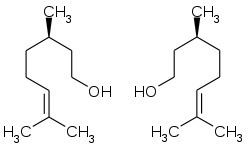Formula C10H20O Density 855 kg/m³ | Molar mass 156.27 g/mol | |
 | ||
Citronellol meaning
Citronellol, or dihydrogeraniol, is a natural acyclic monoterpenoid. Both enantiomers occur in nature. (+)-Citronellol, which is found in citronella oils, including Cymbopogon nardus (50%), is the more common isomer. (−)-Citronellol is found in the oils of rose (18–55%) and Pelargonium geraniums.
Contents
Citronellol by jimmy woodrow
Preparation
Citronellol can be prepared by hydrogenation of geraniol or nerol.
Uses
Citronellol is used in perfumes and insect repellents, and as a mite attractant. Citronellol is a good mosquito repellent at short distances, but protection greatly lessens when the subject is slightly further from the source. When complexed with β-cyclodextrin, it has on average a 1.5 hour protection duration against mosquitoes.
Citronellol is used as a raw material for the production of rose oxide.
Health and safety
The United States FDA considers citronellol as generally recognized as safe (GRAS) for food use. Citronellol is subject to restrictions on its use in perfumery, as some people may become sensitised to it, but the degree to which citronellol can cause an allergic reaction in humans is disputed.
